Sociodemographic and clinicopathologic characteristics of patients treated with high dose rate prostate brachytherapy in Nigeria
Abbas A Abdus-Salam1, Mutiu A Jimoh1, Ayorinde M Folasire1, Atara I Ntekim1, Olabisi T Ojo2, Chiamaka G Ehiedu2, Sikiru A Yusuf2, Augustine O Takure3, Bidemi I Akinlade1, Olusola K Idowu4, Afolabi A Oladeji1, Foluke O Sarimiye1 and Adeniyi A Adenipekun1
1Department of Radiation Oncology, University of Ibadan and University College Hospital, Ibadan PMB 5116, Nigeria
2Department of Radiation Oncology, University College Hospital, Ibadan PMB 5116, Nigeria
3Department of Surgery, University of Ibadan and University College Hospital, Ibadan PMB 5116, Nigeria
4Department of Anaesthesia, University of Ibadan, Ibadan, Nigeria
Abstract
Introduction: Prostate cancer is the most commonly diagnosed malignancy in adult males. High dose rate brachytherapy (HDRB) recently became available in the country for the management of localized prostate cancer in addition to other treatment modalities. HDRB offers a less invasive option to radical prostatectomy and also has a better side effects profile.
Aim: To report the socio-demographic features of the patients treated with HDRB, the clinicopathologic pattern of their disease and possible predictors of these features.
Methods: A retrospective study of patients with histopathologically confirmed prostate cancer, who had HDRB at the Department of Radiation Oncology, University College Hospital, Ibadan, Nigeria, between July 2020 and 2023 was done. Patients’ socio-demographic and clinicopathologic characteristics were extracted from their treatment records.
Results: A total of 73 patients had HDRB within the period under review. The median age was 66 years (51–78 years). About 40% had prostate cancer diagnosed following routine prostate-specific antigen (PSA) screening. The median screening PSA was 20.5 ng/mL (5.83–75.35 ng/mL). About a quarter (24.7%) were asymptomatic at presentation while frequency (60.3%), nocturia (45.2%) and urgency (35.6%) were the most common symptoms. The median initial PSA was 26.00 ng/mL (5.10–124.50 ng/mL) and the median PSA before brachytherapy was 6.25 ng/mL (0.03–175.30 ng/mL), the majority (75.3%) had androgen deprivation therapy before brachytherapy. Forty-seven patients (64.4%) presented with TNM stages 1 and 2 while grade group 2 (24.7%) and high risk (76.7%) were the commonest grade group and risk group, respectively. There was a significant association between age group and TNM stage (p = 0.043), level of education (LOE) and TNM stage (p = 0.037) as well as PSA screening and grade group (p = 0.007).
Conclusion: The majority of the patients who presented for prostate brachytherapy were elderly, had higher initial PSA, were in the high-risk group and had early-stage disease. About 25% of the patients were asymptomatic at presentation. Patients with tertiary LOE and elderly patients presented more with stage 1 and 2 diseases.
Key words: prostate cancer, PSA, routine screening, high dose rate brachytherapy
Correspondence to: Abbas A Abdus-Salam
Email: adrusa@gmail.com
Published: 14/08/2024
Received: 20/03/2024
Publication costs for this article were supported by ecancer (UK Charity number 1176307).
Copyright: © the authors; licensee ecancermedicalscience. This is an Open Access article distributed under the terms of the Creative Commons Attribution License (http://creativecommons.org/licenses/by/4.0), which permits unrestricted use, distribution, and reproduction in any medium, provided the original work is properly cited.
Introduction
At 1.5 million new cases and 396,773 deaths worldwide in 2022, prostate cancer was the second most common cancer to be diagnosed and a leading cause of cancer-related death among males [1]. With an estimated 18,019 new cases and 11,443 deaths in Nigeria in 2022, prostate cancer was the most frequently diagnosed cancer and the primary cause of cancer-related death among males in Nigeria [2]. Nigeria accounted for 17.7% and 20.8% of the new prostate cancer cases and fatalities in Africa in 2022 [2,3].
Prostate cancer is considered a cancer of the elderly with the median age at presentation in Nigeria to be 66 years [4] and most of the patients presenting with adenocarcinoma of the prostate gland [5]. Ahmed et al [4] noted that 33% of 197 prostate cancer patients presented with organ-confined disease and 84.2% of the patients had high-risk disease.
There has been a significant increase in awareness of prostate cancer and willingness to screen among Nigerian men to about 51%–53% [6,7] when compared with what was obtainable in 2009 where 28.7% of men had good knowledge of prostate cancer and only 4.5% of them have been screened [8]. With awareness of routine serum prostate-specific antigen (PSA) screening now widespread, more patients now have an early diagnosis of prostate cancer with patients presenting more frequently with localized disease [9].
High-dose rate (HDR) interstitial brachytherapy can be used for localized prostate cancer management [10–13] and optimal treatment, requires adequate patient selection and risk stratification. The stage, grade and PSA are significant clinicopathologic features of prostate cancer, used in risk stratification. The National Comprehensive Cancer Network defines the following risk stratification: Low risk: T1-T2a, Gleason 2-6 and PSA <10 ng/mL, Intermediate risk: T2b-T2c, Gleason 7 or PSA 10–20 ng/mL and High risk: T3a, Gleason 8-10 or PSA >20 ng/mL [14].
High-dose rate brachytherapy (HDRB) can be used as monotherapy or in combination with EBRT and/or androgen deprivation therapy (ADT), based on risk stratification or as salvage therapy in advanced symptomatic cases [14–19].
The first HDRB equipment was installed in Nigeria in 2019 and this current study is the first of its kind in relation to prostate cancer and HDR treatment coming out of Nigeria. The HDR unit is a remote afterloading system supplied by BEBIG, Germany. The equipment comprises a SagiNova® 25-channel HDR machine, a treatment planning system (SagiPlan®) and a customized ultrasound scanning system with rectal probe, templates, plastic and steel needles while the radionuclide that was used is Colbalt-60. Further details of the equipment and procedures used are described in Abdus-Salam et al [20].
Aim
This study aims to report the socio-demographic, clinicopathologic and predictors of clinicopathologic characteristics of patients with prostate cancer who had prostate brachytherapy at the Department of Radiation Oncology, University College Hospital, Ibadan, Nigeria.
Methods
The study is a descriptive retrospective study of patients with histopathologically confirmed prostate cancer who had high dose rate prostate brachytherapy at the Department of Radiation Oncology, University College Hospital, Ibadan, between July 2020 and 2023. Patients’ socio-demographic (age, tribe, marital status, level of education (LOE), religion and state of residence) and clinicopathologic characteristics (Routine PSA screening, PSA screening value, symptoms, initial PSA (PSA before commencement of any form of treatment), use of ADT and the type of ADT used, PSA value before brachytherapy, TNM staging (PSA and grade group were not used), Gleason score, grade group and risk group) were extracted from the patients’ treatment records. The collected data were analyzed using SPSS v. 22. Results were presented in prose and tables. The student’s t-test was used for quantitative variables and the chi-squared test or Fisher’s exact test was used to test for association between possible predictors and clinicopathologic characteristics. Kolmogorov-Smirnov test was used to test for normality for age, initial PSA and Gleason score while Spearman’s Rho test was used to test for correlation between age, initial PSA and Gleason score. Linear regression analysis was used to test for association between age, initial PSA and Gleason score. The level of significance was set at 0.05. Ethical approval was obtained from, the joint ethical review committee of the University of Ibadan and University College Hospital, Ibadan.
Results
A total of 73 patients had HDR prostate brachytherapy within the period under review. The socio-demographic variables are as detailed in Table 1. The median age of the patients was 66 years (range: 51–78 years) and forty-five patients (61.6%) were over 64 years. Over half of the patients were from the Yoruba tribe (54.8%) and resided in the southwestern part of Nigeria (58.9%). The majority of the patients were married (91.8%), had a tertiary LOE (79.5%) and practiced Christianity (86.3%).
Table 1. Sociodemographic characteristics.
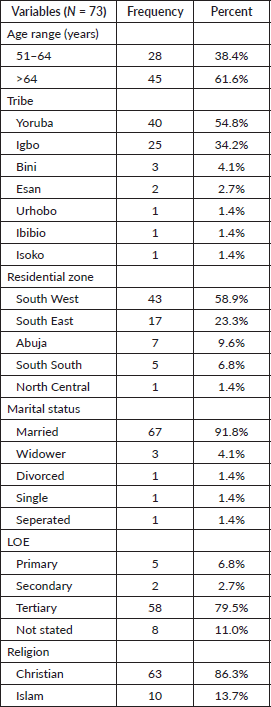
Twenty-nine patients (39.7%) had prostate cancer diagnosed following routine PSA screening, among whom, 37.9% had symptoms on direct questioning and almost half (48.3%) had screening PSA value greater than 20 ng/mL. The median screening PSA was 20.5 ng/mL and ranged from 5.83 to 75.35 ng/mL. Almost a quarter (24.7%) were asymptomatic at presentation while frequency (60.3%), nocturia (45.2%), urgency (35.6%) and weak stream (26.0%) were the most common symptoms among symptomatic patients. Forty-four patients (60.3%) had initial PSA (PSA before any treatment) >20 ng/mL. Fifty-five patients (75.3%) had ADT with androgen receptor blockers (ARBs) being the most common (56.4%). About half of the patients (54.8%) had a PSA value of less than 10 ng/mL before the brachytherapy procedure. The median initial PSA at presentation was 26.00 ng/mL and ranged from 5.10 to 124.50 ng/mL and the median PSA just before brachytherapy was 6.25 ng/mL and ranged from 0.03 to 175.30 ng/mL. Forty-seven patients (64.4%) presented with TNM stages 1 and 2, and the most common histopathologic grade group and risk group were grade group 2 (24.7%) and high-risk group (76.7%), respectively. The clinicopathologic characteristics were are detailed in Tables 2 and 3.
Table 2. Clinicopathologic characteristics.
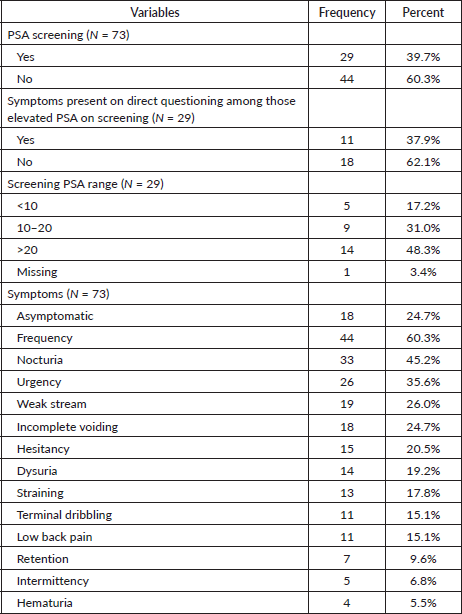
Table 3. Clinicopathologic characteristics.
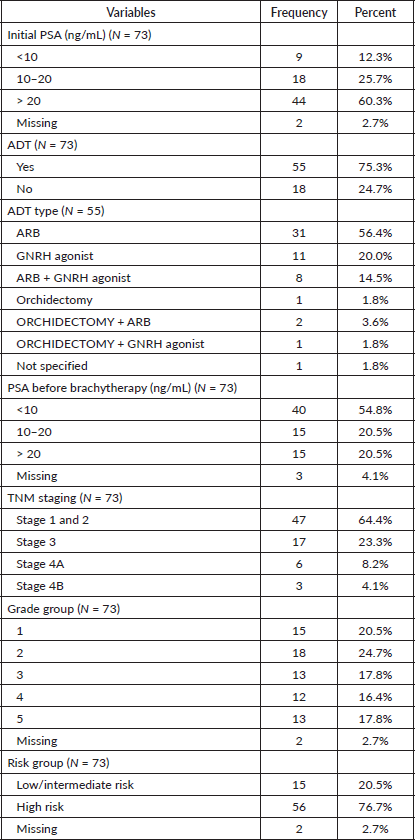
A higher proportion of patients older than 64 years (73.3%) presented with TNM stages 1 and 2 compared with those between ages 51 and 64 years (50%) and this association was statistically significant (p = 0.043). No statistically significant relationship was found between age group and PSA screening, PSA screening value, initial PSA, grade group and risk group (Table 4). There was a slight negative correlation between age and Gleason score though not significant (rs = −0.116, p = 0.168, R2 = 0.022) (Figure 1). There was no statistically significant relationship between residential zone and PSA screening, PSA screening value, initial PSA, TNM stage, grade group and risk group (Table 5). A higher percentage of patients with tertiary LOE (61.5%) presented with TNM stage 1 and 2 diseases compared with those with primary (40.0%) or secondary LOE (50.0%) and this association was statistically significant (p = 0.037). No statistically significant relationship was found between the LOE and PSA screening, PSA screening value, initial PSA, grade group and risk group (Table 6). A higher proportion of patients who were Christians (59.1%) had PSA screening values greater than 20 ng/mL compared to the Muslims who had a higher proportion (83.3%) with PSA screening values between 10 and 20 ng/mL and this association was statistically significant (p = 0.016). No statistically significant relationship was found between religion and PSA screening, initial PSA, TNM stage, grade group and risk group (Table 7). More of the patients who had PSA screening presented with grade group 1 and 2 diseases (25.0% and 46.4%, respectively) compared with those who did not and had more of grade group 3, 4 and 5 diseases (23.3%, 20.9% and 25.6%, respectively). This association was statistically significant (p = 0.007). Test of association between PSA screening and initial PSA, TNM stage and risk group were not statistically significant (Table 8). There was no statistically significant relationship between initial PSA and TNM stage, grade group and risk group (Table 9). There was a non-significant slightly positive correlation between the initial PSA and Gleason score (rs = 0.150, p = 0.109, R2 = 0.046) (Figure 2).
Discussion
The median age of patients in this study was 66 years (range: 51–78 years) with 61.6% being over 64 years. This finding is similar to those of other studies carried out among patients with prostate cancer presenting for prostate brachytherapy which showed median ages ranging from 64 to 71 years [21–25]. This is not unexpected as the incidence of prostate cancer increases with increasing age [10].
Over half of the patients were of Yoruba origin (54.8%) and resided in the Southwestern part of Nigeria (58.9%). This is expected as the facility is located in the Southwestern part of Nigeria where Yoruba is the major ethnic group. This finding is in tandem with those of a study done in Lagos, Nigeria, among patients with prostate cancer [26], though not presenting for prostate brachytherapy. Patients also came from other parts of Nigeria for the procedure and this could be because high dose rate prostate brachytherapy is only available in Nigeria at the Department of Radiation Oncology, University College Hospital, Ibadan, as at the time of this report.
The majority of the patients (91.8%) were married and this is similar to findings from other studies done in Nigeria [26, 27]. This could be explained by the sociocultural practices in Nigeria as shown by the demographic health survey in Nigeria which demonstrated that the percentage of married men increases with increasing age [28] and is not necessarily a hazard posed by marriage. Being married has however been shown to have a lesser risk of late presentation, under-treatment and death [29].
This study showed that the majority (79.5%) of the patients had a tertiary LOE and this was in tandem with the study done by Adewumi et al [26]. This could be attributed to an increased level of awareness which may be due to the literacy status, hence presenting at an early stage which is an indication for prostate brachytherapy. The majority (86.3%) of the patients were Christians and this was also demonstrated by other studies carried out among prostate cancer patients in Lagos and Oyo States [26, 30]. An unexplained significant positive correlation between the practice of Christianity and prostate cancer incidence and a significant negative correlation between the practice of Islam and prostate cancer incidence has been demonstrated [31].
Twenty-nine patients (39.7%) were diagnosed following PSA screening in this study. This could be due to increasing awareness and acceptance of PSA screening by Nigerian men [32]. This study also revealed the median screening PSA value to be 20.5 ng/mL (range: 5.83–78.35 ng/mL) with almost half (48.3%) of the patients having screening PSA value greater than 20 ng/mL. This finding is similar to another study done in Lagos, which showed a PSA screening value greater than 20 ng/mL in 55.8% of patients with prostate cancer diagnosis following screening [33]. This could be because blacks are more prone to have elevated PSA levels and more aggressive diseases [34–37]. Among those who were diagnosed following routine PSA screening, 37.9% had symptoms on direct questioning. This could be due to a lack of awareness of symptoms of prostate cancer or attribution of symptoms to other prostate conditions such as benign prostatic hyperplasia.
Table 4. Age and clinicopathologic characteristics.
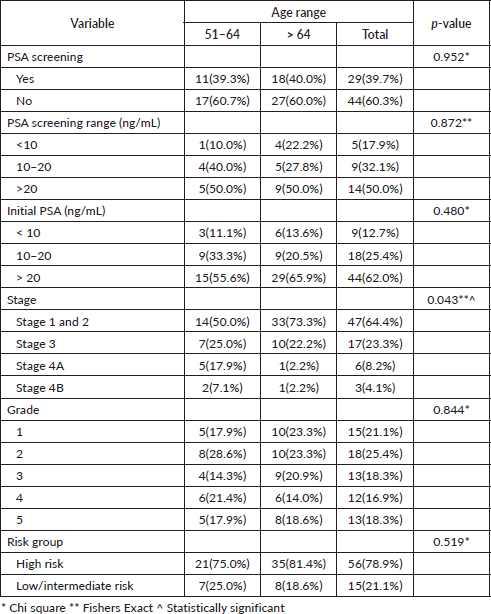
Almost a quarter (24.7%) were asymptomatic at presentation and this emphasizes the need for routine PSA screening. Among those with symptoms, frequency (60.3%), nocturia (45.2%), urgency (35.6%), weak stream (26.0%), feeling of incomplete voiding (24.7%) and hesitancy (20.5%) were the most common symptoms. This finding is in tandem with findings from other studies done in Osun, Lagos, Rivers and Cameroon [26, 38–40]. However, in contrast to findings from these studies, symptoms of distant metastasis were absent in our study as distant metastasis (especially poly-metastasis) is a contraindication for brachytherapy procedures.
Our study showed that the median initial PSA was 26.0 ng/mL (range: 5.10–124.5 ng/mL) with 44 patients (60.3%) having PSA value greater than 20 ng/mL, which classifies them as high risk. This finding is in tandem with results from other studies done in Jos, Ghana and Cameroon which revealed the proportion of patients with initial PSA greater than 20 ng/mL to be 74.0%, 60.7% and 51.4%, respectively [40–42]. The median PSA before brachytherapy was in our study was 6.25 ng/mL (range: 0.03–175.3 ng/mL) with 15 patients (20.5%) having a PSA value greater than 20 ng/mL. This finding is similar to results from other studies which revealed median PSA before brachytherapy to be 7.7 ng/mL and 11.9 ng/mL in the UK and Japan, respectively [43, 44], and the proportion of patients with PSA greater than 20 ng/mL before brachytherapy to be 20.7%, 29.6%, 22.2% and 17.6% in UK, Japan, Ghana and Brazil, respectively [24, 25, 43, 44]. This is not unexpected as some patients, especially those with locally advanced disease commenced ADT before brachytherapy. In our study, 75.3% of the patients had ADT before brachytherapy, with 56.4% having ARBs. This finding is in tandem with studies done in the UK and Australia where 69.2% and 88%, respectively, had neoadjuvant ADT [21, 43].
Our study revealed that 47 patients (64.4%) presented with stage 1 or 2 disease. Studies done in the UK, Australia and Japan revealed similar findings as 72.0%, 70.5% and 66.0% of patients who had brachytherapy had T1/T2 disease, respectively [21, 43, 45]. This finding differs from the results of studies done in Lagos and Cameroon which revealed that 10.4% and 9.5% of patients with prostate cancer, presented with stage 1 or 2 disease, respectively [26, 46]. This difference is because brachytherapy as a treatment option is indicated for localized disease, hence more patients with stage 1 or 2 disease in our study.
Forty-six patients (63.0%) in our study had Gleason scores of 6 or 7 (Grade group 1–3) and this is similar to results from other studies done in the UK, USA and Japan which revealed that 66.2%, 77.0% and 81.7% of patients for brachytherapy had Gleason score 6 or 7, respectively [23, 43, 44]. This finding also explains the early-stage disease found in this cohort of patients as prostate cancer with a Gleason score less than or equal to 7 is less aggressive compared to those greater than 7. Also, this study showed that 76.7% of patients were high-risk. This finding is contrary to the results from 2 studies done in the UK and a study done in Taiwan which revealed that 54.0%, 52.3% and 50.0% of the patients presenting for prostate brachytherapy were high risk, respectively [43, 47, 48]. This difference could be because blacks tend to have higher PSA levels [34–36] and a high percentage (60.3%) of patients from our study had initial PSA greater than 20 ng/mL which classified them as high risk.
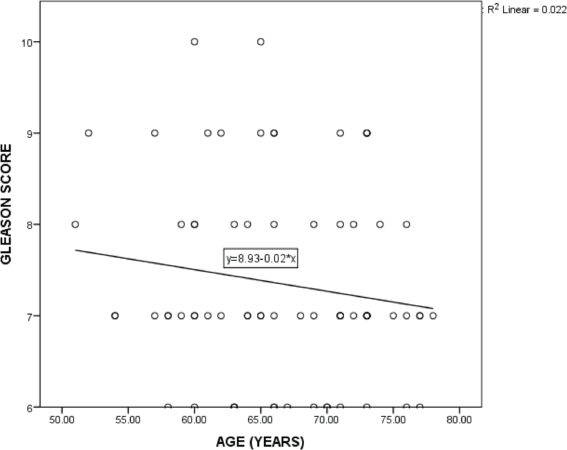
Figure 1. Regression plot of age and Gleason score.
Table 5. Residence and clinicopathologic characteristics.
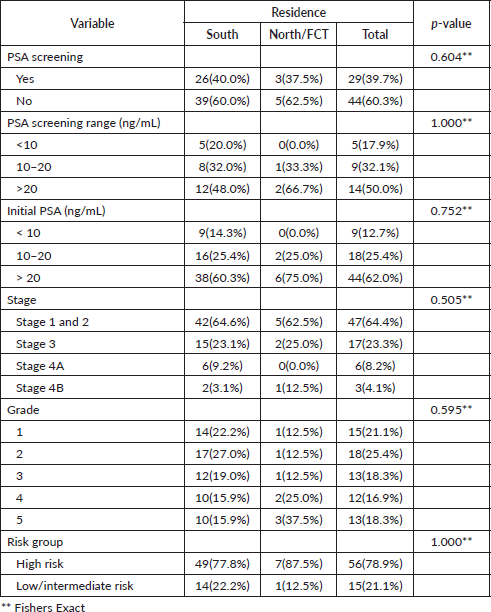
Table 6. LOE and clinicopathologic characteristics.
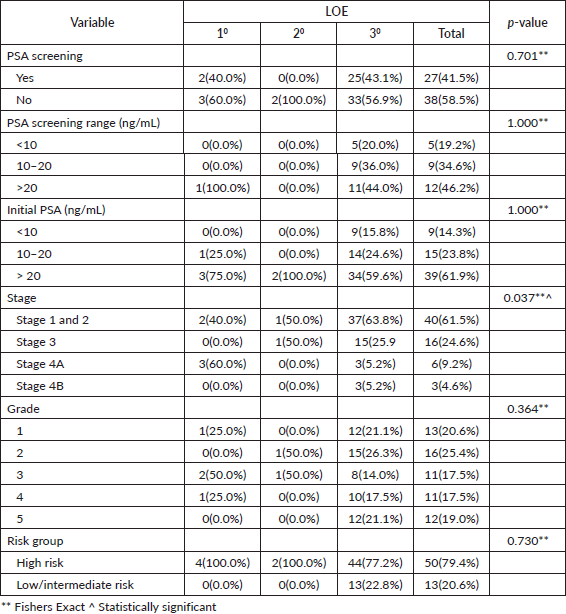
Table 7. Religion and clinicopathologic characteristics.
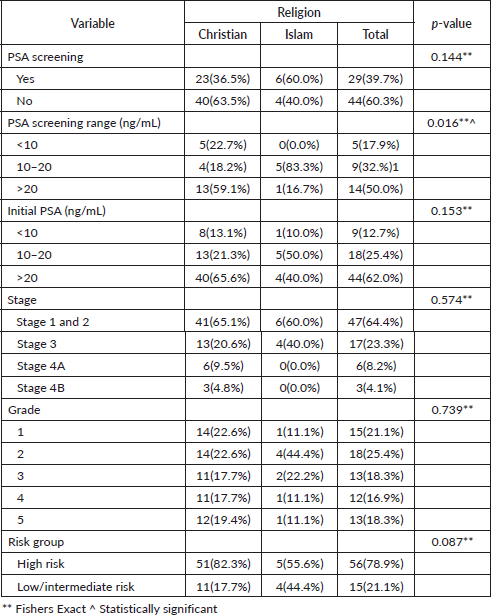
Table 8. PSA screening and clinicopathologic characteristics.
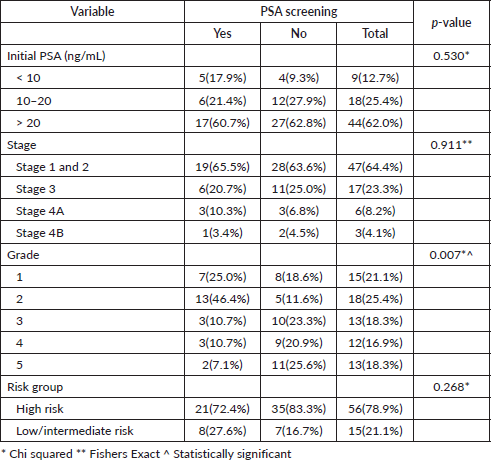
Table 9. Initial PSA and clinicopathologic characteristics.
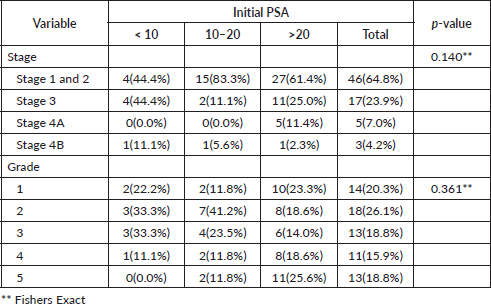
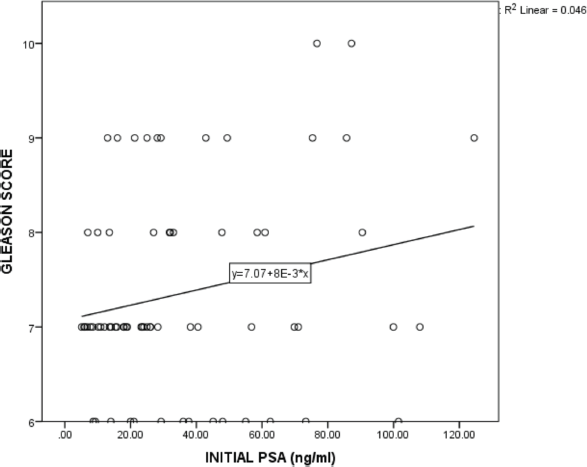
Figure 2. Regression plot of initial PSA and Gleason score.
There was a statistically significant association between age group and stage of presentation (p = 0.043) in our study as a higher proportion of patients over 64 years of age (73.3%) presented with stage 1 or 2 disease compared to those within 51–64 years of age (50.0%). There has been an increase in the incidence of prostate cancer among men 55 years and below, and the patients within this age group are less likely to have organ-confined disease [49]. This supports the school of thought that young African men with prostate cancer usually have an aggressive disease and this could be due to genetic mutation [50], hence the need for more genetic studies in our setting.
In this study, the association between LOE and stage of presentation was statistically significant (p = 0.037) as a higher percentage of patients with tertiary LOE presented with stage 1 or 2 disease compared with those with primary LOE (40.0%) and secondary LOE (50.0%). This could be because men with tertiary LOE tend to be screened [51], have better knowledge of prostate cancer [52] and opt for curative procedures [53].
The association between PSA screening and grade group was also statistically significant (p = 0.007) as a higher proportion of patients who had PSA screening presented with grade 1 (25.0%) or grade 2 (46.4%) compared to those who did not have PSA screening who presented with grade 1 (18.6%) or 2 (11.6%) disease. This finding is similar to the results of a study that revealed that a higher proportion of patients who presented for PSA screening had prostate cancer with a Gleason score less than or equal to 6 compared to those who did not (p < 0.001) [54]. This could be due to the detection of cancer in its early stage following screening as it has been shown that an increase in the grade of prostate cancer can occur especially within the first 2 years of diagnosis [55].
Limitations
Due to the retrospective nature of this study, some data such as PSA values and grade group were missing and could not be reported. The low sample size is also a limitation of this study. Further prospective studies that will explore the sociodemographic and disease characteristics of prostate cancer patients presenting for brachytherapy in Nigeria as well as the effect of these factors on survival are recommended. In addition, further studies on the outcome of the treatment including biochemical controls are currently being worked on. We also hope to compare our outcomes with those of operative procedures including prostatectomies.
Conclusion
This study showed that over half of the patients who presented for prostate brachytherapy were over 64 years old. Most of the patients presented with higher PSA values and were in the high-risk group. The most common grade group were grade groups 1 and 2 and the most common stages were stages 1 and 2 while 24.7% of the patients were asymptomatic. Patients over 64 years and patients with a tertiary LOE presented more with early-stage disease (stages 1 and 2).
This observation calls for more PSA screening and prostate cancer awareness programs especially among young male adults, as this will enable diagnosis of asymptomatic disease and early detection of prostate cancer symptoms which translates to organ-confined disease that will benefit from prostate brachytherapy.
Conflicts of interest
The authors declare that they have no conflict of interest.
Funding
None.
Consent for publication
All authors agreed on the publication of this manuscript.
Ethical consideration
All procedures performed in studies involving human participants were in accordance with the ethical standards of the Institutional and/or National Research Committee and with the 1964 Helsinki Declaration and its later amendments or comparable ethical standards. The study was approved by the joint ethical Committee of the University of Ibadan and University College Hospital Ibadan.
Availability of data and materials
The datasets generated during and/or analyzed during the current study are available from the corresponding author upon reasonable request.
Author contributions
All authors contributed to the study conception and design. All authors took part in the management of all the patients. Data collection was done by Olabisi T Ojo, Akanni S Yusuf and Chiamaka G Ehiedu under the supervision of Abdus-Salam A A and Jimoh M A. Data analysis was done by Chiamaka G Ehiedu and reviewed by Abdus-Salam A A. The first draft of the manuscript was written by Olabisi T Ojo and Chiamaka G Ehiedu and all authors revised and commented on several versions of the manuscript. The final manuscript represents the aggregate of revisions and adjustments by all the authors. It was approved by all the authors.
References
1. International Agency for Research on Cancer; Global Cancer Observatory; GLOBOCAN (2022) All Cancer Fact Sheet (Geneva: WHO) [https://gco.iarc.who.int/media/globocan/factsheets/cancers/39-all-cancers-fact-sheet.pdf]
2. International Agency for Research on Cancer; Global Cancer Observatory; GLOBOCAN (2022) Nigeria Fact Sheet (Geneva: WHO) [https://gco.iarc.who.int/media/globocan/factsheets/populations/566-nigeria-fact-sheet.pdf]
3. International Agency for Research on Cancer; Global Cancer Observatory; GLOBOCAN (2022) Africa Fact Sheet (Geneva: WHO) [https://gco.iarc.who.int/media/globocan/factsheets/populations/903-africa-fact-sheet.pdf]
4. Ahmed RO, Sewram V, and Oyesegun AR, et al (2022) A comparison of clinicopathologic features of prostate cancer between Nigerian and South African black men Afr J Urol 28(1) 6 https://doi.org/10.1186/s12301-022-00273-y PMID: 35280496 PMCID: 8897758
5. Oluwole OP, Rafindadi AH, and Shehu MS, et al (2015) A ten-year study of prostate cancer specimens at Ahmadu Bello University Teaching Hospital (A.B.U.T.H), Zaria, Nigeria Afr J Urol 21 15–18 https://doi.org/10.1016/j.afju.2014.09.004
6. Enemugwem RA, Eze BA, and Ejike U, et al (2019) Prostate cancer screening: assessment of knowledge and willingness to screen among men in Obio Akpor LGA, Rivers State, Nigeria Afr J Urol 25 11(2019) https://doi.org/10.1186/s12301-019-0010-5
7. Ndikom CM, Oluwole TG, and Ilesanmi RE (2021) Risk perception and uptake of prostate cancer screening among a population of Civil Servants in Ibadan, Nigeria Afr J Biomed Res 24 231–237
8. Oladimeji O, Bidemi YO, and Olufisayo JA, et al (2009) Prostate cancer awareness, knowledge, and screening practices among older men in Oyo State, Nigeria Int Q Community Health Educ 30(3) 271–286 https://doi.org/10.2190/IQ.30.3.g PMID: 20860984
9. Novaes PERS, Motta RT, and Lundgren MSFS (2015) Treatment of prostate cancer with intensity modulated radiation therapy (IMRT) Rev Assoc Med Bras 61(1) 8–16 https://doi.org/10.1590/1806-9282.61.01.008 PMID: 25909199
10. Zelefsky MJ, Daly ME, and Valicenti RK (2013) Low-risk prostate cancer Perez and Brady’s Principles and Practice of Radiation Oncology 6th edn (Philadelphia: Lippincott Williams & Winkins) pp 1280–1311
11. Chung HT and Roach M (2013) Intermediate- and high-risk prostate cancer Perez and Brady’s Principles and Practice of Radiation Oncology 6th edn (Philadelphia: Lippincott Williams & Winkins) pp 1311–1333
12. McLaren DB (2012) Kidney, bladder, prostate, testis, urethra, penis Walter and Miller’s Textbook of Radiotherapy: Radiation Physics, Therapy and Oncology 7th edn (Edinburgh: Elsevier Churchill Livingstone) pp 485–509
13. American Cancer Society Treating Prostate Cancer (Atlanta: American Cancer Society) [https://www.cancer.org/content/dam/CRC/PDF/Public/8796.00.pdf]
14. Mohler JL, Armstrong AJ, and Bahnson RR, et al (2012) Prostate cancer, Version 3.2012: featured updates to the NCCN guidelines J Natl Compr Cancer Netw 10 1081–1087 https://doi.org/10.6004/jnccn.2012.0114
15. Strategies for the management of localized prostate cancer: a guide for radiation oncologists [https://www.iaea.org/publications/10618/strategies-for-the-management-of-localized-prostate-cancer-a-guide-for-radiation-oncologists]
16. Mendez LC and Morton GC (2018) High dose-rate brachytherapy in the treatment of prostate cancer Transl Androl Urol 7(3) 357–370 https://doi.org/10.21037/tau.2017.12.08 PMID: 30050796 PMCID: 6043748
17. Recommendations prostate cancer: diagnosis and management guidance NICE [https://www.nice.org.uk/guidance/ng131/chapter/recommendations#assessment-and-diagnosis]
18. Hsu IC, Yamada Y, and Vigneault E, et al (2008) American Brachytherapy Society Prostate High-Dose Rate Task Group (VA: Rosen) p 12
19. Chin J, Rumble RB, and Kollmeier M, et al (2017) Brachytherapy for patients with prostate cancer: American Society of Clinical Oncology/Cancer Care Ontario Joint Guideline Update JCO 35(15) 1737–1743 https://doi.org/10.1200/JCO.2016.72.0466
20. Abdus-Salam AA, Takure AO, and Akinlade BI, et al (2023) Early experience of high-dose-rate interstitial brachytherapy for prostate cancer in Nigeria J Radiat Med Trop 4(1) 1–5 https://doi.org/10.4103/jrmt.jrmt_24_21
21. Zwahlen DR, Andrianopoulos N, and Matheson B, et al (2010) High-dose-rate brachytherapy in combination with conformal external beam radiotherapy in the treatment of prostate cancer Brachytherapy 9(1) 27–35 https://doi.org/10.1016/j.brachy.2009.04.007
22. Yamada Y, Bhatia S, and Zaider M, et al (2006) Favorable clinical outcomes of three-dimensional computer-optimized high-dose-rate prostate brachytherapy in the management of localized prostate cancer Brachytherapy 5(3) 157–164 https://doi.org/10.1016/j.brachy.2006.03.004 PMID: 16864067
23. Wilder RB, Barme GA, and Gilbert RF, et al (2010) Preliminary results in prostate cancer patients treated with high-dose-rate brachytherapy and intensity modulated radiation therapy (IMRT) vs. IMRT alone Brachytherapy 9(4) 341–348 https://doi.org/10.1016/j.brachy.2009.08.003
24. Pellizzon AC, Nadalin W, and Salvajoli JV, et al (2003) Results of high dose rate afterloading brachytherapy boost to conventional external beam radiation therapy for initial and locally advanced prostate cancer Radiother Oncol 66(2) 167–172 https://doi.org/10.1016/S0167-8140(02)00408-5 PMID: 12648788
25. Mensah JE, Yarney J, and Vanderpuye V, et al (2016) Prostate brachytherapy in Ghana: our initial experience J Contemp Brachytherapy 8(5) 379–385 https://doi.org/10.5114/jcb.2016.62972 PMID: 27895678 PMCID: 5116449
26. Adewumi AO, Anthonia SC, and Alabi AS, et al (2016) Pattern of prostate cancer among a Nigerian population: a study in a single tertiary care centre Niger J Med 25(1) 70–76 https://doi.org/10.4103/1115-2613.278256 PMID: 29963824
27. Adus-Salam A, Jimoh M, and Ehiedu CG (2023) Sexual characteristics of patients with prostate cancer seen for radiation treatment Ecancermedicalscience 17 1577 https://doi.org/10.3332/ecancer.2023.1577 PMID: 37533949 PMCID: 10393305
28. National Population Commission (NPC/Nigeria) and ICF (2019) Nigeria Demographic and Health Survey 2018 (Abuja/Rockville: NPC/ICF)
29. Aizer AA, Chen MH, and McCarthy EP, et al (2013) Marital status and survival in patients with cancer J Clin Oncol 31(31) 3869–3876 https://doi.org/10.1200/JCO.2013.49.6489 PMID: 24062405 PMCID: 4878087
30. Boniface I, Bello S, and Ajayi IO (2022) Risk factors of prostate cancer among patients diagnosed at the University College Hospital, Ibadan, Nigeria: a case-control study Epidemiol Health System J 9 119–125 https://doi.org/10.34172/ijer.2022.21
31. Patrick G, Kiana O, and Marvin R (2014) Ethnic belief differences in the incidence and mortality of prostate cancer J Clin Oncol 32(15_suppl) e16108 https://doi.org/10.1200/jco.2014.32.15_suppl.e16108
32. Akinremi T, Adeniyi A, and Olutunde A, et al (2014) Need for and relevance of prostate cancer screening in Nigeria Ecancermedicalscience 8 457 Date accessed: 28/08/14 PMID: 25228913 PMCID: 4154944
33. Ikuerowo SO, Omisanjo OA, and Bioku MJ, et al (2013) Prevalence and characteristics of prostate cancer among participants of a community-based screening in Nigeria using serum prostate specific antigen and digital rectal examination Pan Afr Med J 15 129 https://doi.org/10.11604/pamj.2013.15.129.2489 PMID: 24255735 PMCID: 3830465
34. Mahal BA, Ziehr DR, and Aizer AA, et al (2014) Racial disparities in an aging population: the rela-tionship between age and race in the management of African Amer-ican men with high-risk prostate cancer J Geriatr Oncol 5 352–358 https://doi.org/10.1016/j.jgo.2014.05.001 PMID: 24862107
35. Moses KA, Chen LY, and Sjoberg DD, et al (2014) Black and White men younger than 50 years of age demonstrate similar outcomes after radical prostatectomy BMC Urol 14 98 https://doi.org/10.1186/1471-2490-14-98 PMID: 25495177 PMCID: 4269868
36. Rebbeck TR, Devesa SS, and Chang BL, et al (2013) Global patterns of prostate cancer incidence, aggressiveness, and mortality in men of african descent Prostate Cancer 2013 560857 https://doi.org/10.1155/2013/560857 PMID: 23476788 PMCID: 3583061
37. Kish JK, Yu M, and Percy-Laurry A, et al (2014) Racial and ethnic disparities in cancer survival by neighborhood socioeconomic status in surveillance, epidemiology, and end results (SEER) regis-tries J Natl Cancer Inst Monogr 2014 236–243 https://doi.org/10.1093/jncimonographs/lgu020 PMID: 25417237 PMCID: 4841168
38. Badmus TA, Adesunkanmi AR, and Yusuf BM, et al (2010) Burden of prostate cancer in southwestern Nigeria Urology 76(2) 412–416 https://doi.org/10.1016/j.urology.2010.03.020 PMID: 20451979
39. Ekeke O, Amusan O, and Eke N (2012) Management of prostate cancer in Port Harcourt, Nigeria: changing patterns J West Afr Coll Surg 2(3) 58–77 PMID: 25452994 PMCID: 4240232
40. Cedric TF, Blaise NY, and Etienne A, et al (2018) Epidemiological aspects of prostate cancer at the Medical Oncology Service of the Yaoundé General Hospital-Cameroon Int J Healthc Med Sci 4(9) 66–72
41. Ofoha CG and Magnus FE (2019) Presentation, characteristics and co-morbidities of men with prostate cancer in Nigeria J Adv Med Med Res 31(5) 1–7 https://doi.org/10.9734/jammr/2019/v31i530297
42. Yamoah K, Beecham K, and Hegarty SE, et al (2013) Early results of prostate cancer radiation therapy: an analysis with emphasis on research strategies to improve treatment delivery and outcomes BMC Cancer 13 23 https://doi.org/10.1186/1471-2407-13-23 PMID: 23324165 PMCID: 3558339
43. Chin YS, Bullard J, and Bryant L, et al (2006) High dose rate iridium-192 brachytherapy as a component of radical radiotherapy for the treatment of localized prostate cancer Clin Oncol (R Coll Radiol) 18(6) 474–479 https://doi.org/10.1016/j.clon.2006.04.005 PMID: 16909971
44. Hiratsuka J, Jo Y, and Yoshida K, et al (2004) Clinical results of combined treatment conformal high-dose-rate iridium-192 brachytherapy and external beam radiotherapy using staging lymphadenectomy for localized prostate cancer Int J Radiat Oncol Biol Phys 59(3) 684–690 https://doi.org/10.1016/j.ijrobp.2003.11.035 PMID: 15183471
45. Sato M, Mori T, and Shirai S, et al (2008) High-dose-rate brachytherapy of a single implant with two fractions combined with external beam radiotherapy for hormone-naive prostate cancer Int J Radiat Oncol Biol Phys 72(4) 1002–1009 https://doi.org/10.1016/j.ijrobp.2008.02.055 PMID: 18448272
46. Kaboré FA, Zango B, and Kambou T, et al (2014) Prostate cancer disease characteristics at the time of diagnosis and initial treatment offered in a Tertiary Hospital at Ouagadougou (Burkina Faso) Open J Urol 04 7–12 https://doi.org/10.4236/oju.2014.41002
47. Hoskin PJ, Rojas AM, and Bownes PJ, et al (2012) Randomized trial of external beam radiotherapy alone or combined with high-dose-rate brachytherapy boost for localized prostate cancer Radiother Oncol 103(2) 217–222 https://doi.org/10.1016/j.radonc.2012.01.007 PMID: 22341794
48. Chen YC, Chuang CK, and Hsieh ML, et al (2007) High-dose-rate brachytherapy plus external beam radiotherapy for T1 to T3 prostate cancer: an experience in Taiwan Urology 70(1) 101–105 https://doi.org/10.1016/j.urology.2007.03.008 PMID: 17656217
49. Lin DW, Porter M, and Montgomery B (2009) Treatment and survival outcomes in young men diagnosed with prostate cancer: a population-based Cohort Study Cancer 115(13) 2863–2871 https://doi.org/10.1002/cncr.24324 PMID: 19466697 PMCID: 2948666
50. Hussein S, Satturwar S, and Van der Kwast T (2015) Young-age prostate cancer J Clin Pathol 68(7) 511–515 https://doi.org/10.1136/jclinpath-2015-202993 PMID: 25837493
51. Kilpeläinen TP, Talala K, and Raitanen J, et al (2016) Prostate cancer and socioeconomic status in the Finnish Randomized Study of screening for prostate cancer Am J Epidemiol 184(10) 720–731 https://doi.org/10.1093/aje/kww084 PMID: 27777219
52. Adibe MO, Aluh DO, and Isah A, et al (2017) Knowledge, attitudes and perceptions of prostate cancer among Male Staff of the University of Nigeria Asian Pac J Cancer Prev 18(7) 1961–1966 PMID: 28749629 PMCID: 5648405
53. Kilpeläinen TP, Talala K, and Taari K, et al (2020) Patients’ education level and treatment modality for prostate cancer in the Finnish Randomized Study of screening for prostate cancer Eur J Cancer 130 204–210 https://doi.org/10.1016/j.ejca.2020.02.045 PMID: 32229417
54. Martin RM, Donovan JL, and Turner EL, et al (2018) Effect of a low-intensity PSA-based screening intervention on prostate cancer mortality: the CAP randomized clinical trial JAMA 319(9) 883–895 https://doi.org/10.1001/jama.2018.0154 PMID: 29509864 PMCID: 5885905
55. Sheridan TB, Carter HB, and Wang W, et al (2008) Change in prostate cancer grade over time in men followed expectantly for stage T1c disease J Urol 179(3) 901–905 https://doi.org/10.1016/j.juro.2007.10.062 PMID: 18207195 PMCID: 4251426






